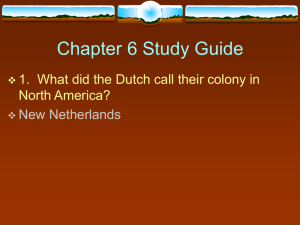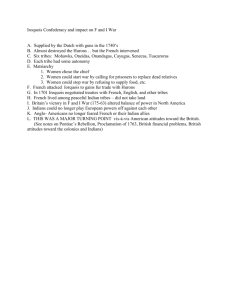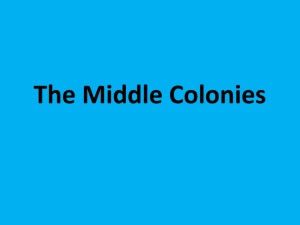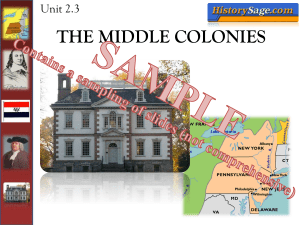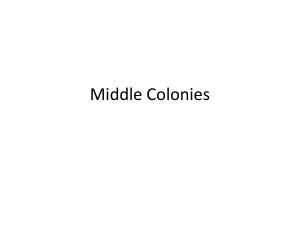Chapter 4
advertisement
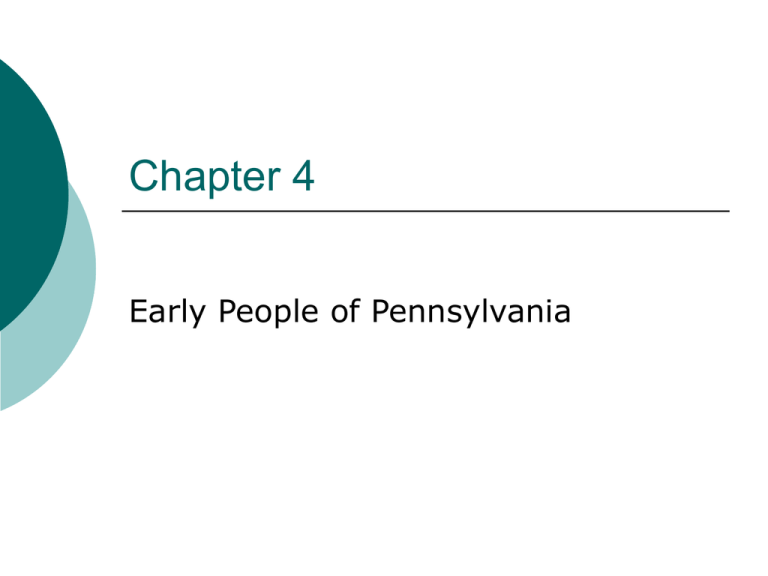
Chapter 4 Early People of Pennsylvania I. Native American Tribes in Pennsylvania Their Migration 1. Historians think that Native American tribes migrated from Asia during Ice Age. a. Historian- People who make a living out of studying and teaching history. b. Heritage- deals with all the events of a family or culture’s past generation. c. Migrate- to move from one region or location to another. d. Archeologists- people who study the past by digging up evidence, such as tools and pottery from locations of past cultures. A. B. Eastern Woodland Nations in Pennsylvania. Iroquois League of Nations. a. separated by language. b. divisions: Cayuga, Mohawk, Oneida, Onondaga, and Seneca. 2. Algonquin League of Nations. a. Separated by language. b. Divisions: Delaware( LenniLenape), Shawnee, Nanticoke. 1. C. Native American Culture. 1. a. b. 1. 2. Government Clan- a group of Native American family members who live in a small village. Council- a group of Native American men selected to run a clan. Selected by women of the clan. Council selects a chief. a. Iroquois - council’s job was to keep peace among tribes - Chief had to get agreement of council before making a decision. b. Algonquin - Chief selected to settle disagreements and lead the tribe into battle. 2. Rules of Men, Women, and Children Men 1. Did the jobs that required greater strength. 2. Built homes, cut down trees, made weapons, hunted, fished, protected the village, made canoes. b. Women 1. Were well respected in their communities. a. 2. Master of houses, owned the house and field, made pottery, cleaned meat and fish, prepared two meals a day, gathered firewood, retrieved water, made clothing. c. Children 1. Boys- taught to hunt, fish, and make weapons. 2. Girls- Stayed with their mothers to learn the jobs of women. 3. Food Provides Hunters Men hunted for animals such as fox, raccoon, beaver, turkey and squirrel. Gatherers. 4. Clothing - Women made skirts, shirts, leggings, and moccasins from deerskin. a. 5. Shelter Iroquois tribes built longhouses. 1. Longhouses were built for many families. 2. All relatives lived together (as many as 12 families) b. Algonquin tribes built wigwams and sweathouses. 1. Wigwams are houses made for one family. three shapes: rounded, cone or rectangular. 2. Sweathouses were used to cure illness and clean the body. there was a separate house for men and women. heated rocks were placed in water. a. 6. Economy Bartering or trading. 1. Barter means to trade one item for another. 2. Native Americans bartered with European settlers b. Wampum- are strings of white shell beads made from clam shells. Used as a means of trading. Iroquois tribes used the strings of beads to record stories and events. • White Beads- symbol of peace • Black beads- symbol of sadness. a. 7. Transportation Canoes b. Trails 1. Many present day roads and streets follow Native American trails. 8. Religion. a. The Great spirit b. Algonquin had a sacred relationship with the environment. 1. Treated animals with respect. c. Iroquois believed they connected the Great Spirit through their dreams. a. II. Early European Settlements in Pennsylvania. The English began to settle along the eastern shore of the Atlantic Ocean. 1. Jamestown, Virginia 2. Plymouth, Massachusetts B. Dutch and French 1. Explored parts of land that is Pennsylvania. 2. Explored the Delaware Bay. 3. Sailed north on the Delaware River. A. at first they missed the river that empties into the Delaware River. that river was the Schuylkill River, Schuylkill means hidden river in Dutch. C. Swedish 1. Started a colony near Wilmington, Delaware. a. Colony is a location settled by people. b. John Printz was sent to run the colony. - He moved the colony to Tinicum Island. 2. This was the first permanent settlement in Pennsylvania. 3. Permanent means to stay in one location. D. Spanish 1. Claimed land near Florida. 1. E. Conflicts A conflict- means to fight or to war because of a disagreement. 2. Swedish tried to capture a Dutch fort. a. Peter Stuyvesant, the governor of New York gathered seven ships and 300 soldiers to attack the Swedish colony. The Swedish surrendered. Surrendered means to give up or be defeated in a fight. 1. 3. The English attacked the Dutch. a. With Dutch colonies at New York and near Philadelphia the English king became nervous. He gathered troops and ships for an attack. b. The Dutch surrendered without firing a shot. F. Customs and Names Swedish A. showed settlers how to build log cabins. B. Introduced the first cows to Pennsylvania land. 2. Dutch A. Brought sleighs and ice skating. B. Had front doors that opened in halves. C. Introduced the custom of St. Nicholas, who was known as Santa Claus. D. Dutch names that we use today are Schuylkill River, cookie, and waffle. 1.
